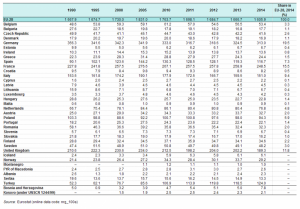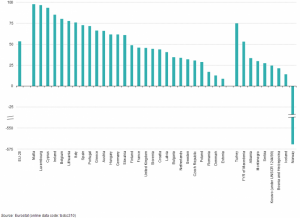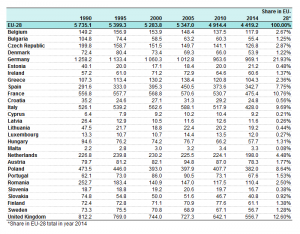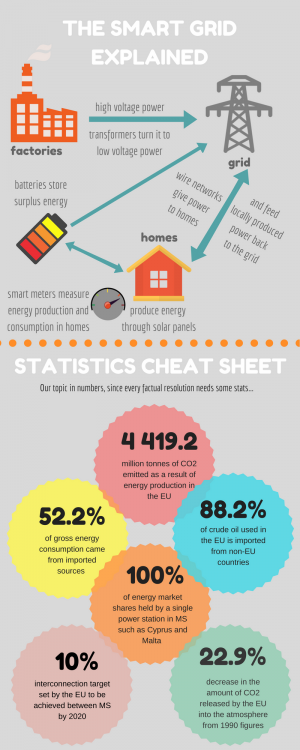Category:Heidelberg:ITRE II
| “ | 'Timing matters: What measures should the EU take in order to increase energy efficiency from production to consumption and across sectors? | ” |
Optimising energy efficiency is one of the top priorities of the EU’s Energy policy. The Union is currently facing issues with energy wastage, dependency on foreign imports and has set goals for lowering energy consumption of the 2007 levels by 20% in 2020. Increasing energy efficiency from the very first step of production down to the commercial consumer is a matter which can yield multi-faceted benefits: it can reduce the amount of environmental degradation which results from energy production, decrease electricity costs and energy dependency from countries outside the Union, as well as make the EU energy market more competitive. Thus, with the development of new, environmentally friendly technologies, key steps leading to the ideal Energy Union - from production to consumption - are required.
Contents
Relevance
Energy efficiency is one of the EU's primary goals seeing as it can benefit the economy, the environment and consumers alike. The inefficient production and consumption of energy is propagating and worsening the effects of global warming, polluting the air and lowering the quality of life in cities. In light of Article 194 of the Treaty of the Functioning of the European Union, the EU continuously aims to provide:
- ‘security of energy supply in the Union’,
- ‘promote energy efficiency and the development of new and renewable forms of energy’
- ‘promote the interconnection of energy networks’[1].
With environmental protection and energy policy being such a fundamental goal of the Union, the efficiency of the energy sector in production, transportation and consumption, should be ensured.
Energy consumption: facts and stats

With energy production moving towards more sustainable sources, consumption in EU households seems to also be decreasing, albeit rather slowly. This reduction in consumption by households is rather significant, since it accounts for as much as 24.8% of the Union's total. Energy consumption in households in the EU thus fell by 1.3%, as explained by Eurostat[2]. However, this decrease is not equally distributed among MS, with a majority actually experiencing an increase in their electricity consumption (although mostly by less than 10%). Energy conservation efforts, including the installation of conservation equipment, may play a part in this overall decrease; although it is speculated that it is mostly linked to demographic changes. It is however, tantamount to ensure that energy consumption is further reduced in households, where possible, utilising environmentally friendly technologies.
Energy production: facts and stats
Energy in the EU is produced through a multitude of sources, chiefly combustible fuels and nuclear power plants, making up for 47,6% and 27,4% of energy production in the Union in 2014, respectively[3] . Recently, however, the importance of renewable energy sources has increased, as highlighted by Eurostat reporting a massive increase of solar and wind power production from 0.02% in 2004 to 3.2%[4] of the net electricity production of the EU by 2014. Surprisingly, renewable energy sources were the only resource that experienced such a uniform growth from 2004 to 2014. There is a long way to go until our energy production becomes more environmentally friendly, sustainable, and efficiently utilises our natural resources.
What is perhaps alarming, is that primary production in the EU has experienced a slump in the years from 2010 to 2014, which does not correspond to a similar drop in demand, with energy production being 17.3 % lower in 2014 than it was in 2004 .
Main issues, opportunities and challenges:
Challenges
Dependency on foreign imports

One of the greatest challenges the EU faces in terms of its energy sector, is how greatly dependent it is on foreign imports. Eurostat records that since 2004, energy imports have been higher than the primary production of energy in the EU, meaning that the Union is overwhelmingly dependent on foreign countries to secure its energy sector. More specifically, foreign imports increased from less than 40% of gross energy consumption in the 1980s to 53.5% in 2014. The highest energy dependency recorded was for crude oil, at 88.2% and natural gas, at 67.4%[5].
Energy dependency is also varied across MS, from Estonia, Denmark, Romania and Poland depending on foreign imports for less than 30% of their gross domestic energy consumption, to Luxembourg, Malta and Cyprus, recording an over 90% dependency on foreign imports. The reasons for this disparity, are the very differing natural resources in different MS, as well as the lack of development and competitiveness of the energy sector of many of these MS. Another fact which displays the Union's overwhelming energy dependency is that there is no MS in the EU which actively engages in energy exports. Denmark used to be the only exporter, until 2013, when the country also began importing energy. This creates a great problem for the Union, which seems to have no surplus energy and often cannot hold its own when it comes to satisfying energy demand with its own primary production.
Uneven supply and demand
A drawback of renewable energy sources is the uneven supply and demand of electricity. The demand for electricity fluctuates throughout the day[6], as well as throughout the year, and with renewable sources being used, so does supply. Solar panels for example, produce energy only during the day, and in much greater volume during the warmer months. Thus, it is important to balance the grid and match supply to demand, meaning that either renewable power stations must limit their production during times of low demand, or that energy is not consumed and eventually wasted. Uneven supply and demand can also affect the EU regionally, as the energy needs of each country may vary greatly, due to such things as: time differences and seasonal requirements (air-conditioning/heating)[7]. The problem is intensified as the analog grids, currently used in most EU Member States, do not involve any storage facilities and, for the most part, do not account for energy wastage as a direct result of uneven demand and supply of energy.
Environmental concerns

A stark drawback of conventional energy production is environmental degradation. Only less than one-fifth of the overall energy production of the Union is derived from renewable energy sources, meaning that for the rest, the EU is utilising fossil fuels or nuclear energy, leading to destructive consequences on the environment.
In 2014, Eurostat reported that the EU as a whole, emitted 4 419.2 million tonnes of greenhouse gases into the atmosphere , as a result of energy production from non-renewable sources. Despite this figure being 22.9% lower than the amount released in 1990[8] environmental damage caused by the release of such a large amount of CO2 and other greenhouse gases into the atmosphere, lead to the depletion of the ozone layer, and consequently, global warming. In fact, due to the amount of environmental degradation which can result from the use of nuclear energy, Germany has sworn off using it. Meanwhile, two reactors in Belgium have been shut down, after the discovery of cracks.[9]
Monopolies and weak energy market
Another major issue faced by the Union in terms of energy production is the lack of market liberalisation in the electricity production sector in many Member States. For example, in small States such as Cyprus or Malta, the largest power generator held 100% of the market share for electricity in 2014, according to Eurostat[10]. This is an area of concern for the issue of energy efficiency, as it means that the production of electricity in the country is subject to limited or no investment in the free market, potentially hindering the sector’s growth.
Energy monopolies in Member States, have a lot to do with the public sector as well. In many cases, monopoly in the energy sector exists due to the fact that the biggest electricity production company in the country is state-owned. Such is the case in France, for example, where Electricité de France (EDF) currently provides 90% of the country's net electricity[11], especially for residential consumption. The most common argument in favour of this is protection of consumers, as state-owned enterprises are less likely to hold consumers to ransom by cutting supply when the monthly fee is not payed, or raise prices unaccountably. There is also the issue of infrastructure development, an often very costly enterprise, which is not easily taken up by private firms, unless a private monopoly is guaranteed. For this reason, the state often builds energy infrastructure and subsequently also manages it.
Nevertheless, market liberalisation is, one of the key goals of the Commission when it comes to the energy market, as it would allow consumers to choose their providers freely, instead of being forced to abide by the standards of a single- or in any case, very few- companies.
Opportunities
Better infrastructure
Energy sharing between MS
In order to be able to match demand to supply in power and ensure that countries can guarantee energy supply to their citizens (even in the case of a spontaneous halt in the use of imported fossil fuels), it is tantamount for MS to co-operate with each other. Moreover, further investments in infrastructure will allow energy to flow freely and efficiently throughout the EU. Thereby, the vision of the Energy Union could be achieved and the problems regarding the existence of ‘energy islands’ throughout the Union would be addressed.
The European Council set a 10% interconnection target to be completed by 2020, which the Commission believes should be extended to 15% by 2030[12] Investment in such cross-border connective infrastructure is a key step in ensuring stable energy supply and prevent wastage.
The Baltic region sets a good example of inter-connectivity initiatives, with two Estlink connections linking Estonia and Finland; the Litpol link connecting Lithuania and Poland; and Nordbalt between Sweden and Lithuania. [13]. All these initiatives have raised the inter-connectivity of the Baltic countries to the EU energy sector by up to 22%. The Baltic Energy Market Interconnection Plan (BEMIP) aims to integrate the energy market in the baltic region even further, by establishing a common power exchange within the Baltic region, completely removing tariffs and filling holes in the demand and supply systems of the interconnected countries. Such regional initiatives also exist in Nordic countries, whereby effective energy exchange takes place through the monitoring of possible energy deficiencies and by adjusting production in neighbouring countries to account for it. Price areas are thereby determined, in order for fairer pricing of energy to be facilitated, while legal barriers are effectively overcome[14].
Smart Grids
Smart grids are the latest technology in the energy sector. The current grid system present in most MS is considered outdated, as it allows only a one-way flow of electricity from production stations and storing facilities to the consumers. As mentioned above in the uneven demand and supply challenge, conventional grids cannot respond to the unequal demand and supply of energy at different times of the day or the year. In contrast, the smart grid establishes a two-way communication line, involving the consumers, production facilities and storage facilities, in order to balance the demand and supply of energy more effectively. As part of smart grids, the energy demands of the country are measured and recorded, and energy is better distributed to consumers.
Specifically, digital meters allow consumers to have in-depth information on their energy consumption. This could help consumers, themselves, monitor their consumption and limit it where possible, to curb costs as well as harmful effects on the environment. Other gadgets available as part of Smart grids include
- Phrasor Measurement Units, which allow processors to assess grid stability, thus preventing malfunctions
- automated feeder switches, which can reroute energy traffic around any possible problems in the system
- batteries, able to store excess energy produced during hours of low demand and re-supply it to the system when demand rises.[15]
Increasing Energy Efficiency in Households
In recent years, the EU has placed increasing importance on energy efficiency in households. As part of this ambition to cut down energy consumption by households, the EU endorses and provides incentives for the creation of energy efficient household appliances, meeting minimum energy efficiency targets, for example. Ecodesign regulations require that manufacturers ensure that their products consume the lowest amount of energy possible. The regulations, set at a European level, under Directive 2009/125/EC of the European Parliament and of the Council, ensure that manufacturers of products mentioned in the Directive, such as (but not limited to): air heating and cooling tools, computers, televisions, domestic cooking appliances, abide by the energy efficiency regulations. The Commission monitors the implementation of this Directive, as well as managing any bilateral agreements with manufacturers of other types of goods.
Another way in which the EU encourages energy efficiency in Household products sold within the Union is through the introduction of harmonised energy labels. These help consumers determine which products are most energy efficient, and thus also, most cost efficient for them. The scale proposed by the Commission in 2015, goes from A to G, with the most energy-efficient products being labelled A. Indeed, since the introduction of labels in 1995, energy efficient products have attracted more and more customers, effectively urging manufacturers to create increasingly energy efficient products. The result of these labels, combined with the Energy Efficiency Directive is predicted to save around 175 million tonnes of oil, as well as 465 euros per year in each household's energy costs.
Policy already in place/being discussed
2030 Framework for Climate and Energy
European Energy Security Strategy
Energy Union
Energy Efficiency Directive
Sum up
To sum up, the energy market in the European Union is a booming sector, which however, is undergoing major changes in recent years and still has a long way to go until it is sufficiently efficient. Corporate interests, although respected, may need to be compromised, in order to achieve market liberalisation (the lack of which is currently holding back the market), while consumers and smaller businesses may also need to change their habits. Indeed, with the EU so majorly emphasising the importance of a well-integrated Energy Union, pushing for a shift to renewable energy sources and calling for energy conservation at every level, it is time to look into the concrete measures that are required in order to reach the ambitious goals set forth in the 2030 Agenda, achieve de-carbonisation by 2050, but most importantly: ensure that energy production in the Union is as effective and as efficient as possible.
Infographic
Further Research
- A quick and useful video guide to power grids
- Fun video explaining energy efficient products/appliances in the EU
- Another creative video showing how other methods can be utilised in households to increase energy efficiency
References
- ↑ http://www.lisbon-treaty.org/wcm/the-lisbon-treaty/treaty-on-the-functioning-of-the-european-union-and-comments/part-3-union-policies-and-internal-actions/title-xxi-energy/485-article-194.html
- ↑ http://ec.europa.eu/eurostat/statistics-explained/index.php/Consumption_of_energy
- ↑ http://ec.europa.eu/eurostat/statistics-explained/index.php/Electricity_production,_consumption_and_market_overview
- ↑ http://ec.europa.eu/eurostat/statistics-explained/index.php/Electricity_production,_consumption_and_market_overview
- ↑ http://ec.europa.eu/eurostat/statistics-explained/index.php/Energy_production_and_imports
- ↑ https://www.eia.gov/todayinenergy/detail.php?id=830
- ↑ https://www.eia.gov/todayinenergy/detail.php?id=4190
- ↑ http://ec.europa.eu/eurostat/statistics-explained/index.php/Greenhouse_gas_emission_statistics
- ↑ http://www.europarl.europa.eu/atyourservice/en/displayFtu.html?ftuId=FTU_5.7.5.html
- ↑ http://ec.europa.eu/eurostat/statistics-explained/index.php/Electricity_production,_consumption_and_market_overview
- ↑ http://www.economist.com/node/3485202
- ↑ http://www.europarl.europa.eu/legislative-train/theme-resilient-energy-union-with-a-climate-change-policy/file-15-electricity-interconnection-target
- ↑ https://ec.europa.eu/energy/en/topics/infrastructure/baltic-energy-market-interconnection-plan
- ↑ http://www.nordicenergy.org/article/interconnected-nordic-power-systems/
- ↑ https://energy.gov/oe/services/technology-development/smart-grid
Pages in category "Heidelberg:ITRE II"
The following 4 pages are in this category, out of 4 total.

